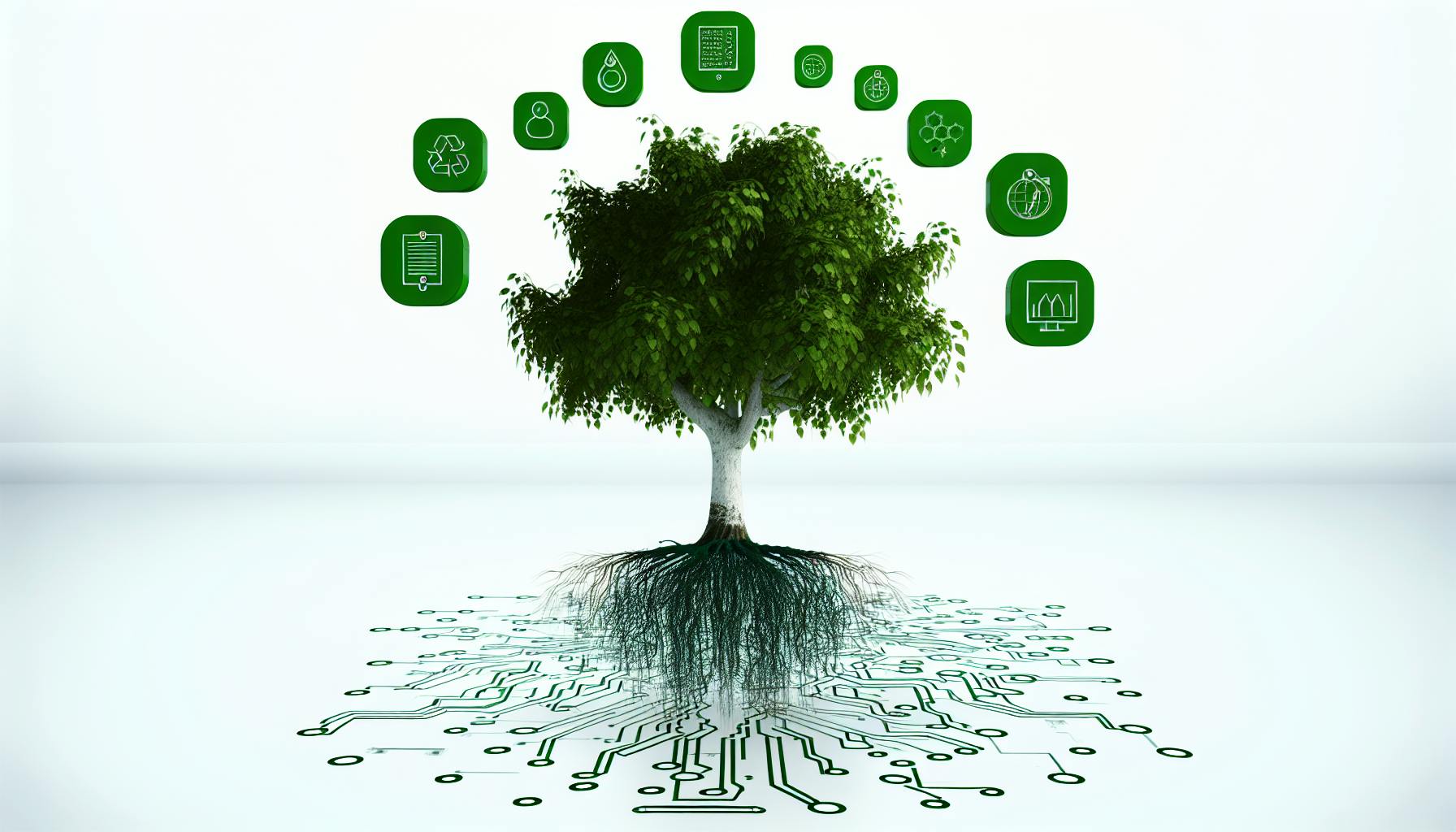Tracking and reporting carbon emissions can be an arduous task for small and medium enterprises (SMEs).
Utilizing a carbon accounting tool can help streamline compliance, simplify reporting, and unlock strategic insights.
This article explores how the right carbon accounting software enables SMEs to efficiently meet regulatory demands while charting a greener course.
Introduction to Carbon Accounting Tools for SME Compliance and Reporting
As small and medium-sized enterprises (SMEs) face increasing pressure from regulators, investors, and customers to limit their environmental impact, implementing a robust carbon accounting strategy has become crucial. However, the complexities of measuring, tracking, and reporting greenhouse gas (GHG) emissions can be daunting for companies without dedicated sustainability teams. This is where carbon accounting tools can provide welcome relief.
By leveraging purpose-built software, SMEs can simplify compliance, streamline carbon reporting, and gain actionable insights to drive emission reductions. From calculating your overall climate footprint to modeling various decarbonization scenarios, carbon accounting platforms make the process straightforward and cost-effective. They can also help demonstrate accountability and progress to key stakeholders.
In this article, we'll explore the key benefits carbon accounting tools offer SMEs on their net zero journey.
Understanding Carbon Accounting Software Market Dynamics
The global carbon accounting software market has experienced remarkable growth in recent years in response to intensifying policy and societal focus on climate change mitigation. Valued at USD 6.3 billion in 2021, the sector is projected to increase at a compound annual growth rate (CAGR) of 11.5% through 2030.
Much of this momentum comes from small and mid-sized firms seeking user-friendly technology to cost-efficiently comply with GHG reporting requirements and harness sustainability as a competitive edge with customers. By integrating automated data collection and analysis features that mesh with existing business platforms and workflows, carbon accounting systems enable actionable insights without overburdening limited resources.
As stakeholders ramp up demands for emissions transparency and regulators finalize new disclosure rules, turnkey software solutions will become indispensable for SMEs navigating the low-carbon transition.
What are carbon accounting tools?
Carbon accounting tools like EcoHedge's software provide businesses with an automated way to measure, report, and reduce their carbon emissions. These tools track a company's carbon footprint across all scopes of emissions and identify opportunities to lower environmental impact.
Key benefits of using a carbon accounting tool include:
- Simplifying compliance with rapidly emerging sustainability regulations
- Identifying emission hotspots to focus reduction efforts
- Engaging stakeholders through detailed and credible emissions reports
- Making progress towards Science Based Targets and net-zero commitments
For small and medium enterprises (SMEs), adopting carbon accounting technology can streamline the previously complex and manual process of carbon reporting. With intuitive dashboards and easy data input, tools like EcoHedge allow sustainability managers to spend less time crunching numbers and more time enacting change.
Rather than risking non-compliance fines or stakeholder scrutiny, SMEs can leverage user-friendly software to efficiently meet carbon accounting and reporting demands. This allows leadership teams to benchmark progress and clearly communicate achievements to customers and investors.
As pressure mounts globally for corporations to curb emissions, carbon accounting tools give SMEs the key capabilities once only accessible to organizations with ample sustainability staff. By making carbon accounting achievable for companies of all sizes, this software drives environmental responsibility across every sector and supply chain.
What is the carbon accounting method?
Carbon accounting is a systematic approach to measuring, reporting, and managing greenhouse gas (GHG) emissions from organizational activities. Similar to financial accounting, carbon accounting provides quantitative insights to help businesses understand, track, and reduce their climate impact over time.
Why is carbon accounting important?
Carbon accounting serves several key functions:
- Helps organizations identify their largest sources of emissions and prioritize reduction opportunities. By breaking down emissions data by scope, source, and operational units, companies can pinpoint hotspots to focus change efforts.
- Allows businesses to benchmark performance over time. Consistently tracking emissions creates a baseline to compare against and indicates whether efforts are effectively decreasing a company's carbon footprint.
- Supports compliance with evolving climate regulations and standards. Many jurisdictions now require companies to measure and publicly disclose emissions. Robust carbon accounting enables accurate reporting.
- Provides verified data to communicate sustainability progress to stakeholders. Investors, customers, and employees are increasingly demanding climate action and performance transparency from companies.
In summary, advanced carbon accounting tools empower organizations to make data-driven decisions to meet pressing carbon management needs. The method plays an indispensable role in corporate climate strategies.
What is the world's most widely used carbon accounting method?
The Greenhouse Gas (GHG) Protocol is the world's most widely used carbon emissions accounting standard. Developed by the World Resources Institute (WRI) and the World Business Council for Sustainable Development (WBCSD), it provides standards and guidance for companies and organizations to measure and report their greenhouse gas emissions.
Some key things to know about the GHG Protocol:
- Used by most major companies globally to guide carbon accounting and reporting
- Breaks emissions into 3 scopes - Scope 1 for direct emissions, Scope 2 for indirect emissions from purchased energy, and Scope 3 for value chain emissions
- Allows consistent and transparent tracking and comparison of emissions over time
- Supports companies in setting science-based emission reduction targets
By following the GHG Protocol methodology, companies like EcoHedge customers can accurately measure carbon outputs, identify high-impact areas to reduce emissions, and benchmark progress in cutting their carbon footprint. This standardized approach is vital for not only tracking sustainability initiatives but also meeting regulatory compliance demands from stakeholders. For SMEs struggling to make sense of carbon accounting, leaning on GHG Protocol brings confidence that their processes align with best practices.
What is the formula for carbon accounting?
The basic formula for carbon accounting is:
GHG emissions (CO2e) = Activity data x Emission factor
Where:
- Activity data refers to the quantifiable amount of something, like liters of fuel burned, kilometers travelled, kWh of electricity used, etc.
- Emission factor is the amount of emissions released per unit of activity data. For example, burning one liter of diesel may release 2.7 kg of CO2e.
Emission factors are often calculated through life cycle assessments (LCAs) that consider all emissions generated during production, transportation, use, and disposal of a product or service.
For travel companies, the emission factor calculations can get quite complex, taking into account various modes of transport, lodging, meals, and activities.
Carbon accounting tools like EcoHedge use established emissions factors databases and methods to accurately convert activity data into CO2e emissions. This saves companies time while ensuring consistency and compliance.
sbb-itb-919600f
Demystifying Carbon Accounting for SMEs
Carbon accounting can seem daunting for small and medium enterprises (SMEs). Still, it has become an indispensable tool for meeting sustainability compliance mandates and engaging stakeholders. This article explores how carbon accounting tools help SMEs navigate environmental regulations more accessible, allowing them to enhance operational sustainability.
Unlocking Free Carbon Accounting Tool Advantages
Free carbon accounting tools offer an attractive option for SMEs seeking cost-effective climate reporting solutions. While basic, they provide core functionality like measuring Scope 1 and 2 emissions from key activities, minimal customization, basic visualizations and reporting. As examples, tools like EcoChain and Regio help compile emission inventories and generate simple carbon reports.
However, free tools have limitations like lack of lifetime carbon accounting, third-party verification options, and advanced customizations. Still, they allow SMEs just embarking on their net zero journey to get started with carbon measurement rapidly. As their maturity and reporting needs grow more sophisticated, SMEs can upgrade to more advanced paid tools.
Strategic Insights with the Best Carbon Accounting Tool
The best carbon accounting tools provide enhanced capabilities that transform SMEs' climate strategies. Features like automated data import from various sources, custom Scope 3 emissions, scenario modeling, offsets management, stakeholder engagement modules, and advanced visualizations better inform decisions.
For instance, solutions like Persefoni and Sphera offer comprehensive carbon accounting tailored to companies' operational realities. The contextual insights derived help SMEs set ambitious, science-based targets, identify emission hotspots for reduction, optimize value chain sustainability, and improve climate risk resilience. Investing in such tools is a strategic choice that empowers long-term, ethical growth.
How Carbon Accounting Software Companies Are Shaping the Future
Leading carbon accounting software companies like Watershed and Carbon Analytics are pushing the envelope in product innovation. Areas like blockchain integration for transparency, AI-enabled accurate and real-time tracking, tying emissions data to financial metrics, comprehensive stakeholder engagement platforms, and easy integration with existing systems are seeing rapid advancement.
These solutions capture the expanding complexity of climate action reporting. They allow SMEs to become sustainability leaders within their peer network by harnessing accurate, standardized, and holistic emissions data for decision-making. As compliance regulations grow more stringent worldwide, these companies' continued technology innovation will prove indispensable for SMEs seeking smooth regulatory compliance and climate resilience.
Comparing Carbon Accounting Platforms: A Comprehensive Guide
As climate change accelerates and sustainability regulations tighten, small and medium enterprises (SMEs) are under growing pressure to track, report and reduce their carbon emissions. Adopting carbon accounting software can streamline this complex process through automated data collection, real-time analytics and detailed reporting.
However, with many solutions now available, conducting due diligence is essential to determine the best platform for your company's specific needs and budget. This guide examines key considerations around core features, user experience, pricing models and more to inform your software comparison.
Engaging in Carbon Accounting Software Comparison
Selecting suitable carbon accounting software requires scrutinizing solutions across three main evaluation criteria:
Core Functionality
- Emissions Scopes - Does the software track all relevant GHG protocol scopes for your operations?
- Calculations - Are emissions quantified via accurate, up-to-date methodologies and conversion factors?
- Reporting - Can the platform generate customized reports e.g. sustainability reports, CDP disclosures?
- Target Setting - Does it facilitate setting science-based emission reduction targets?
- Offsetting - Can you use the software to invest in certified carbon offsets?
Ease of Use
- Data Imports - What data types and sources can it import to calculate emissions?
- Dashboards - Are the user dashboards intuitive? Do they visualize key metrics effectively?
- Integrations - Does it connect smoothly with your existing finance, logistics and other platforms?
- Support - Is sufficient training, assistance and documentation provided?
Costs
- Pricing Model - Is it affordable for your operating budget? How do costs scale with emissions volumes?
- Implementation - What internal effort is required for rollout and ongoing maintenance?
- ROI - Will efficiency gains outweigh expenses over time?
Cross-comparing solutions to pinpoint one aligning closely with your unique priorities takes time but delivers huge long-term value through informed decision making. Consult free platform trials, independent software reviews and peer insights to complement your own hands-on evaluations.
This rigorous selection process upfront ensures the platform you implement can cost-effectively meet current compliance needs while providing foundations to continually improve sustainability performance over time.
Leveraging Carbon Accounting for Business Transformation
Carbon accounting tools provide small and medium enterprises (SMEs) an opportunity to transform their business operations in pursuit of sustainability goals. As stakeholders demand greater climate accountability, these platforms enable companies to measure, understand, and reduce their environmental impact.
Streamlining Carbon Measurement
A quality carbon accounting tool integrates smoothly into existing business processes. By automatically tracking emissions data across the company, it eliminates the need for manual data collection and spreadsheets. Not only does this save time and effort, but it also minimizes human error, improving the accuracy of carbon accounting. With a comprehensive view of emissions sources, SMEs can identify "hot spots" to target for reductions.
Achieving Net Zero Goals
With robust analytics and data visualizations, carbon accounting tools provide actionable insights to create environmental strategies. By simulating different reduction scenarios, companies can model pathways to achieve net zero emissions on self-determined timelines. As priorities change, tools recalculate optimal paths so SMEs can adapt plans while maintaining sights on end goals.
Gaining a Competitive Edge
Sustainability is increasingly an ethical imperative and competitive necessity. By taking early climate action, progressive SMEs stand out to investors, employees, and consumers. Carbon accounting tools enable organizations to set ambitious goals and make credible progress claims. Rather than see sustainability as just a cost, forward-looking companies recognize its potential for innovation, efficiency gains, and revenue growth.
Selecting the Right Carbon Accounting Tool: Key Considerations
As businesses aim to reduce their environmental impact, many small and medium enterprises (SMEs) are turning to carbon accounting tools to streamline the process. With sustainability regulations and stakeholder expectations on the rise, it's crucial to choose a solution tailored to your unique needs.
When evaluating options, keep these key factors in mind:
Ease of Use
The platform you choose should integrate seamlessly into existing business workflows. It should be intuitive for staff at various levels to navigate. Prioritize solutions with simple dashboards, automated data collection, and customizable reporting. The easier it is to use, the more likely your team will adopt it.
Data Accuracy
Precision matters - your tool should use the latest emissions factors and have flexible data import options to capture all sources. Make sure it follows established protocols like the GHG Protocol to produce compliant reports. Consider the level of analysis needed - some solutions specialize in product or investor-focused lifecycle estimates.
Customization
Every SME has unique requirements - select software that allows custom categories, goals, and formats. This ensures your reports speak to stakeholders and you can tailor strategies over time as regulations change. Ideally, the platform should also integrate with other business software through API connections.
Ongoing Support
Consider not just the features, but the level of customer support and continued platform development. This space evolves rapidly, so active maintenance and regular updates are key. Prioritize providers invested in improving their users' emission accounting experience.
While initially daunting, choosing the right carbon accounting software doesn't have to be difficult. Keep your specific aspirations, stakeholders, and processes top of mind. The tool you implement today can provide the foundation for your net zero journey.
Success Stories: SMEs Excelling with Carbon Accounting Tools
Carbon accounting tools provide critical solutions for small and medium-sized enterprises (SMEs) on their sustainability journey. With strong commitments to reducing their environmental impact, these organizations serve as inspirational examples of implementing automated emissions tracking successfully. Their stories showcase the tangible benefits SMEs can achieve by leveraging the right technology.
Laundry service company MyWash adopted EcoHedge's carbon accounting software and achieved a 12% emissions reduction in their first year. By analyzing their supply chain impacts and operational energy usage, MyWash identified efficiencies like switching to biogas for industrial dryers. Their sustainability manager Jamie says "With granular insights from EcoHedge, we engaged employees around our footprint and rewarded teams that helped us cut carbon."
Another SME excelling with carbon accounting tools is AltBreads bakery. By connecting their smart meters to EcoHedge software, AltBreads tracks their real-time energy consumption. This allows them to optimize baking schedules, machinery runtimes, and refrigeration to minimize waste. Owner Tara explains "We reduced our emissions by 8% annually using data from EcoHedge to guide our operations. Our customers love our green credentials too!"
These examples show that SMEs can gain quantifiable sustainability improvements using comprehensive carbon accounting. With the power of data and automation on their side, companies like MyWash and AltBreads engage stakeholders through their decarbonization achievements. By providing detailed reporting and strategic recommendations, advanced tools like EcoHedge empower enterprises of all sizes to account for and reduce their footprint. The success stories speak volumes about streamlining compliance demands while saving money as a bonus.
Conclusion: Charting a Greener Course with Effective Carbon Management
As environmental regulations and stakeholder expectations around sustainability continue to evolve, small and medium enterprises (SMEs) are recognizing the need to better understand and reduce their carbon footprints. However, the carbon accounting process can be complex, time-consuming, and resource intensive without the right tools.
This is where carbon accounting software can make all the difference. Purpose-built solutions like EcoHedge Express provide SMEs with automated and accurate tracking of scope 1, 2, and 3 emissions based on the Greenhouse Gas Protocol. Not only does this simplify compliance with mandatory reporting schemes, but it also generates the data and insights needed to drive science-based emission reduction strategies.
With granular visibility into carbon hotspots across operations and supply chains, SMEs can pinpoint and address inefficiencies. Features like stakeholder engagement modules also empower businesses to effectively communicate their sustainability stories and climate action plans.
As societies and economies chart more sustainable pathways, environmental accounting enabled by software tools like EcoHedge will be key. By shining a light on carbon footprints, these solutions give SMEs the compass they need to navigate toward their net zero north stars.



